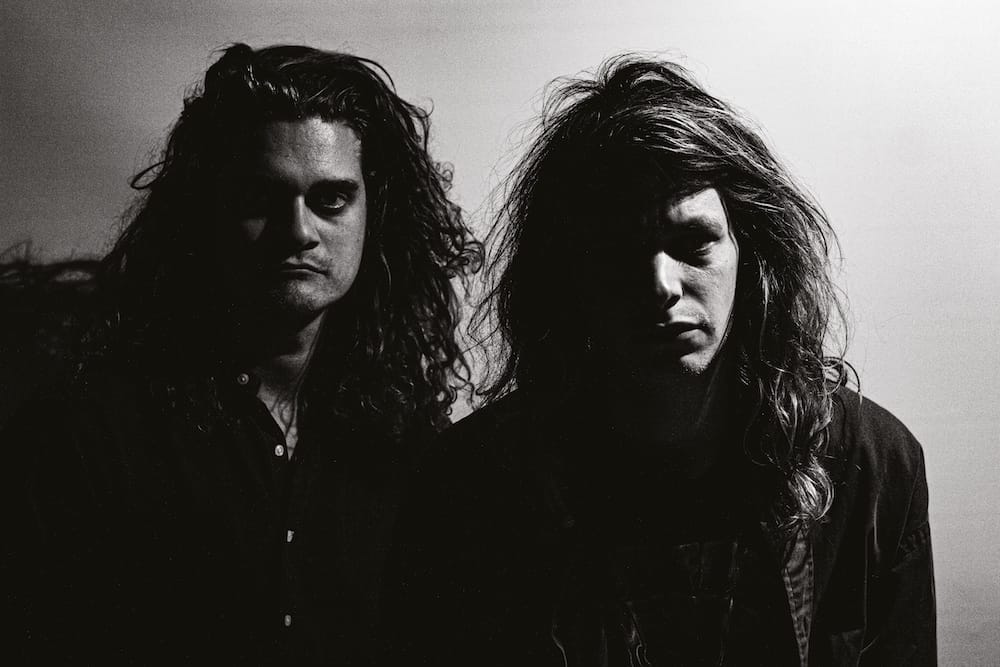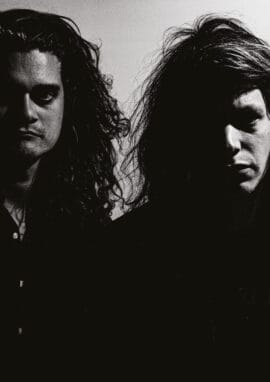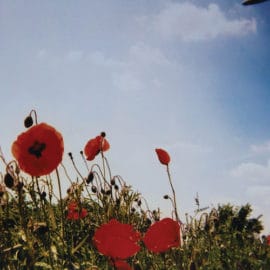Of the many black metal scenes scattered around the globe, the Dutch one is probably the most quirky. FLUISTERAARS recently presented a prime example of this with their third album „Bloem“. In an interview with Bob Mollema, the duo’s front man answered our questions about the flourishing concept of the record, the influence the landscape of his home country might have on the unusual sound of many bands there, and his opinion on plastic flowers.

Let’s start at the beginning: What inspired you to become a professional musician?
I will speak to this question on behalf of the band. Since we were young we have been involved in music. We all come from a free musical nest in which we were exposed to different genres at a young age. As we grew older, our own quest began. Making music was a logical consequence. We wanted to imitate our heroes because we felt they could translate our feelings so well. In this way, it has slowly but surely become a personal outlet pushed by our passions and emotions.
What was the artistic vision you had for FLUISTERAARS and to what extent has it changed until today?
With FLUISTERAARS we are busy translating our world view into music and what goes with it. Our worldview has not changed so much over the years, but has become deeper and more powerful. Our music grows side by side with us. We draw much inspiration from ancient folklore, philosophy and the wide range of music that exists in the world. We are very critical of this society, but at the same time realize that it is complicated to give up completely. Our music is for us personally a key to a, in our opinion, better world. A world in which the state is extinguished and in which people arrange things among themselves without a higher hand. Over the years, as I said earlier, this vision has been sharpened and deepened. You can hear that in the music, but you can also read it in the lyrics and see it in the artwork. That our vision is catching on is evident from our growing fan base.
The Dutch black metal scene is considered to be very distinct in style. What do you think is the reason why so many bands in your country sound that unusual even for black metal standards?
It may have something to do with our flat landscape. This ensures that you can see far, but also that you can be easily viewed. The influences reach you more easily. It is densely populated and there are many different nationalities who all have a different past or bring something new when they come here. It is almost guaranteed to come into contact with new cultures because cities are not so far apart. Even if you come from a small village, influences reach you and that is why the Netherlands never comes to a standstill. If you live in a remote mountain village in Austria, it is damn difficult to encounter physical new influences. Of course there is also the internet, but the internet also means that you can make a choice in influence and inspiration, so that it always remains your own choice. So in my opinion the landscape is a major player in the Dutch black metal sound. It is subject to constant change and innovation, I wonder what others think about this in the scene. Nice question!
I also have the impression that the black metal community in the Netherlands is quite connected – there are a lot of bands with an overlapping lineup. How important is it for you personally to be involved in all that?
By collaborating with each other you learn a lot from others but also about yourself. This broadens your scope and strengthens your vision.

Your new album „Bloem“ is centered around the flower as a symbol of decay and regeneration – a very untypical concept for a black metal band. How did you come up with this idea?
It has two meanings for us personally. The first is that we have emerged ourselves and threw open all hatches for new influences and experiences. We want FLUISTERAARS to be exposed to that too, so as always our band follows us on our life path. We see this growth and emerging as an escape from the uniformity that sometimes still prevails in the scene. There is nothing wrong with that, but since FLUISTERAARS is such a big part of our personal lives, we have to break free from conventions and let art speak.
The album is also about legends that contain flowers. Sometimes they are combinations of old stories and myths, and sometimes they are poems based on the sense of reincarnation. Flowers are very mystical because they are strong and beautiful just before they die. They die immediately afterwards. While people weaken to a bag of misery. In this sense, a flower makes more impact and has no fear.
„Bloem“ is aesthetically very different from your previous releases and contains slightly shorter songs. Would you say that you have reinvented FLUISTERAARS on this album?
We always try to take it in a different direction. Luckily we never know where it’s going to but in the end we have trust in the end result.
How did fans and the press react to the rather unusual characteristics of „Bloem“? And how important is the feedback from fans and press to you?
We have only received, seen and read positive responses so far. The number of plays on the digital platforms skyrocketed. In addition, the physical variants are also sold out. That has never happened so quickly. For us, this is a confirmation that people appreciate our music and understand the message.
What was the first thing that you came up with for „Bloem“ – the concept or the music? And to what extent did one influence the other?
Music came first with this album. The pre-productions had a direction that had a strong appetite for nature and mysticism. Suddenly I got a call from Mink who had seen a field of poppies in the intro to „The Great Escape“. When I saw it I immediately knew; that’s the picture. From that moment on we can interpret the music as the life path of a flower. It was an organic process that we enjoyed. The music and the lyrics have also guided each other. That was interesting to see. Sometimes I wanted some to be supported by a particular piece, but vice versa. The revealing pieces of music to which the text is attuned, for example. During the making of this album I learned that music can be very visual.
 While some tracks like „Tere Muur“ sound pretty intense, there are also more moderate songs like „Eeuwige Ram“ on „Bloem“. To what extent is that related to the lyrical content of the respective songs?
While some tracks like „Tere Muur“ sound pretty intense, there are also more moderate songs like „Eeuwige Ram“ on „Bloem“. To what extent is that related to the lyrical content of the respective songs?
The song „Tere Muur“ is about the demise of beauty. The lyrics tell this in a poetic way. The next track „Nasleep“ is about acceptance of decay. This is followed by „Eeuwige Ram“ and in terms of lyrics this track is about a blurred vision of a cult performing a ritual, but it is unclear from the person who receives the vision. The vision keeps coming back and the person slowly accepts that he starts to rise again. Then „Vlek“ starts and with that the circle actually starts again. The last track, „Maanruïne“, is about an ancient house on the moon in which all these things are determined. That track is transcendent because it is above reciprocity and rather decisive. I’m not going to tell everything, but that’s kind of the way the lyrics and the music are a whole.
Besides the instruments that are common in metal, there are also brass instruments played by a guest musician on „Bloem“. Why did you find it fitting to include trumpet and trombone in your new songs?
The horn has long been a symbol of initiation, but also of closure. On all fronts that fits perfectly with the theme of this album.
How will you handle this at concerts (as soon as they are possible again)? Do you plan to use session musicians for the brass parts or will you rather adapt the songs for your usual live line-up?
We don’t play live. If we will in the future we will work together with good people.
Do you already know whether you will use instruments which are unusual in black metal more often in the future?
We do not yet have any insight into this. It just depends on how future albums develop. Based on that, we can only decide what fits. Of course we are not going to say „we now want to use a clarinet, how can we make an album that fits nicely?“
Unfortunately, there are many narrow-minded listeners in the black metal community who reject themes and aesthetics like that of „Bloem“. Can you understand to a certain degree that some people think that things like that don’t fit this kind of music?
As I mentioned before, it’s okay to stick to the uniformity of the scene. But if you really want to be a rebel and change the world then you have to let go and be open. People who stick to uniformity are trapped and slaves to a certain idea. That’s something we don’t support at all. So I would like to ask those people to love themselves and to break the chains.
On the other hand, a certain connection to nature, which one could also associate with „Bloem“ for obvious reasons, is often found in black metal. How important to you personally is a relation to nature as opposed to urban surroundings?
Everyone in this band grew up in the most natural environment in the Netherlands. The Veluwe. In the end we also had experience with urban life, but we kept returning. At the center of those two extremes is a tremendous energy where we find ourselves. What we find there is inspiration to take a critical look at the urban environment and to increase our desire for nature. By balancing in the middle it is also possible for us to sometimes return to the urban environment to take people to nature through our art. Nature is our greatest inspiration because by studying it one can find out that we are insignificant and must therefore respect the majestic nature and see ourselves as a guest.
 In keeping with the theme, there is a photograph of poppies on the cover, but the picture structure seems almost a little arbitrary. Why did you find it nevertheless fitting that way?
In keeping with the theme, there is a photograph of poppies on the cover, but the picture structure seems almost a little arbitrary. Why did you find it nevertheless fitting that way?
It is anything but random. This photo was the best in a series. The analog quality appeals to us and the composition actually puts the flowers on a pedestal. They tower above us and are therefore threatening in their beauty. Not afraid of dying and overshadowed. They are as Douglas Pierce would say; martyrs of beauty.
The music scene is currently very much affected by the corona virus and the necessary counter measures. How has this affected FLUISTERAARS?
We sympathize with all the musicians and artists who suffer from this. We also suffer from this in our personal lives. Fortunately, FLUISTERAARS do not suffer because people often recommend our music as perfect quarantine music.
How will you continue with FLUISTERAARS now? Will you maybe use the time of retreat to work on new music?
That’s for us to know and for you to find out. We are always busy and more motivated than ever. Keep an eye on our Instagram and Facebook page and you will find out.
Let’s end with a short brainstorming. What do you think of the following terms?
Hippies: If they skip the dreadlocks they could be our best friends.
Jazz: Very nice and sometimes very confusing.
Plastic flowers: Kitsch, but everlasting. The human mind likes to trick itself; you don’t have to water them.
Climate crisis: We must do everything in our power to reduce emissions. People should make more conscious choices together and stop taking things for granted. I think transparency would ensure this, but unfortunately that is hard to find in a world of lies and shit flies.
Lo-fi production: The golden standard.
Reincarnation: Who knows, but I have a lot of memories which are untraceable.
Thanks again for your time. Would you like to say a few last words to the readers?
Thanks reading, thanks for listening and thanks for living. Please follow us on Instagram and Facebook.
Dieses Interview wurde per E-Mail geführt.
Zur besseren Lesbarkeit wurden Smilies ersetzt.
